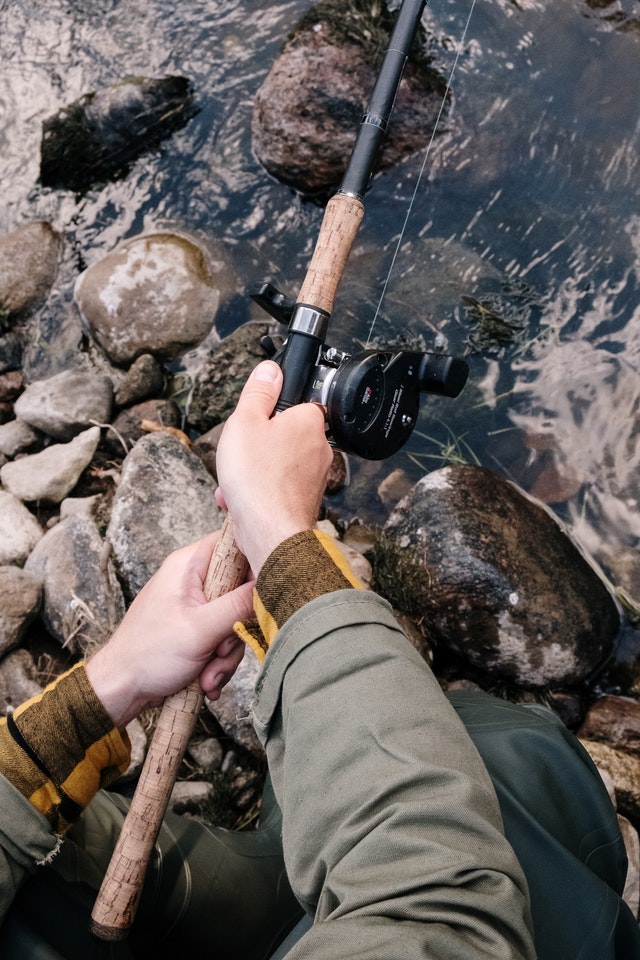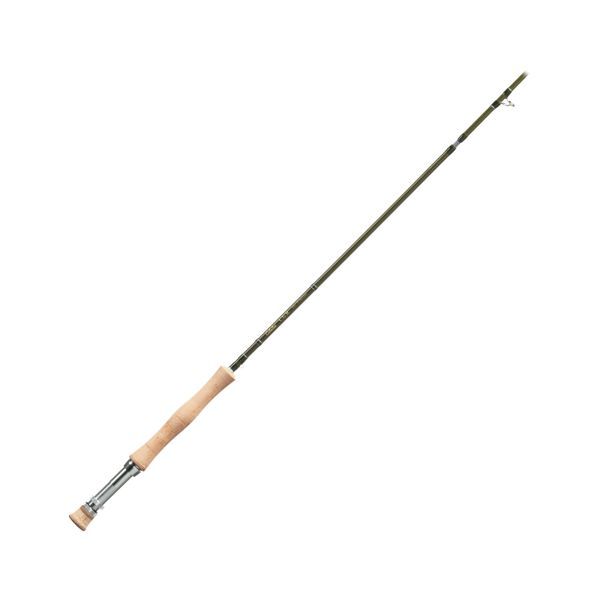If you are into fishing, you know how important fishing rods are when it comes to scoring a good catch. So what are fishing rods made of? Fishing rods are made from a wide variety of materials including different types of metals and wood. Different types of rods come with different features, however, if you are a newbie, you might have a hard time deciding which one is best for you. Here is a comprehensive guide that will discuss different types of fishing rods, the materials fishing rods are made of, and how they affect your fishing.
What are Fishing Rods?
A fishing rod consists of a long pole with a line that is held in place with the help of guides. A fishing reel is attached to the rod that stores the line and the angler uses the reel to take up and let out the fishing line. The loose end of the line has a hook that holds the bait which is kept at the right level in water with the help of floaters or sinkers.
Fishing rods have been around for a while. Back in the day they were made from wood, bone, or stone and were just about an inch long. The rods used to be pointed at both ends with a line and a bait attached to it. Initially, anglers would use these rods to fish from boats, but soon longer rods started to be used that allowed anglers to fish from the shore. There is a written account of an ancient fishing rod from the 4th century BC. This was a bamboo rod that used a silk line, a needle as a hook, and rice as bait.
Materials Used to Make Fishing Rods
Fishing rods have evolved a lot over the years. Nowadays there are a ton of different types all of which are used for different purposes. Mentioned below are some of the most commonly used materials to manufacture fishing rods,
Bamboo
- 2 PIECE CONSTRUCTION This bamboo fishing pole comes in a two piece that measures approx 6.5 feet fully assembled, This 3 set includes 3x of 2 part bamboo pole, 3 bobbers, 3 hooks, 3x fishing line with winder and 3 sinkers.
- ., Its a great stepping stone before moving to a more intricate pole.
- PONDS, CREEKS AND RIVERS This is a great way to fish in small bodies of water that you might not need a large pole for
Prices pulled from the Amazon Product Advertising API on:
Product prices and availability are accurate as of the date/time indicated and are subject to change. Any price and availability information displayed on [relevant Amazon Site(s), as applicable] at the time of purchase will apply to the purchase of this product.
Bamboo rods have been used for hundreds of years and are still being used by anglers. Bamboo is one of the first materials that rod manufacturers started using. When it comes to natural fishing rod materials, there is no better alternative than bamboo. It is strong, bendy, and flexible which makes it ideal for making fishing rods. However, bamboo rods are also a bit heavier than the materials used by modern manufacturers. This makes them susceptible to breaking much more easily. Still, many fishermen use bamboo rods because of their historic value. Plus, they are great for fly fishing which is why fly fishermen prefer these over other fishing rods.
Fiberglass
- Full-flexing, slow action
- Superb feel and tippet protection
- High-quality guides, reel seat and grip
- Includes protective rod case
Prices pulled from the Amazon Product Advertising API on:
Product prices and availability are accurate as of the date/time indicated and are subject to change. Any price and availability information displayed on [relevant Amazon Site(s), as applicable] at the time of purchase will apply to the purchase of this product.
Fiberglass was reportedly used for the first time by a manufacturer in the early 1940s to make fishing rods. Fiberglass is a lot like bamboo, in that it is quite bendy and flexible. However, one of the things that give it an edge over bamboo rods is that it is way more durable. It is also much more affordable and a lot lighter in weight.
Fiberglass rods bend in a parabolic arc. Which means that the whole rod bends from top to bottom when the line is lifting up a weight. These rods are best for new anglers as they don’t break that easily and are also quite inexpensive.
Graphite
- AMAZING QUALITY CARBON FIBER BLANK - Constructed with Toray 24-ton carbon matrix KastFlex blank technology. Available in 29 sizes from an ultra light spinning fishing rod to a heavy 7’ spinning rod and a baitcaster rod ranging from medium to heavy power.
- PREMIUM COMPONENTS - KastKing uses the best quality components in a Perigee II fishing rod. World renowned Fuji O-Ring line guides, tuned ergonomic graphite high-strength reel seats.
- SMOOTH POWER - Specialized high technology computer control wrapping at four angles (0⁰, 45⁰, 90⁰, 135⁰) keeps the power flowing.
Prices pulled from the Amazon Product Advertising API on:
Product prices and availability are accurate as of the date/time indicated and are subject to change. Any price and availability information displayed on [relevant Amazon Site(s), as applicable] at the time of purchase will apply to the purchase of this product.
Manufacturers first started using graphite to make fishing rods in the 1960s which took the sport of fishing to the next level. Graphite is a lot lighter, stronger, and much more durable than both bamboo and Fiberglass. This allowed manufacturers to make rods that were longer, thinner, and way more sensitive in the tip because of their stiffer build and structure.
One of the best things about graphite rods is that you can fish with them for hours without getting tired because of how light they are. Moreover, you get a lot of power with graphite rods which means you can cast further.
Furthermore, the added sensitivity in the tip gives you a lot more control and detects even the most subtle bites which allow you to catch a lot more fish.
Carbon Fiber
- Warm Prompt: Full Kit with Carrier Case include 1 FISHING ROD + 1 FISHING REEL + FISHING LINE + VARIOUS FISHING LURES + FISHING HOOKS + SOME NECESSARY ACCESSORIES + CARRIER BAG.
- Full Kit with Carrier Case is special made for novice, including necessary accessories for fishing.
- Perfect elasticity, high density Carbon fiber mixed with fiberglass make your fishing pole hard & durable. Stainless Steel Hooded Reel Seats is anti-seawater corrosion; EVA Fore Grip for comfort.
Prices pulled from the Amazon Product Advertising API on:
Product prices and availability are accurate as of the date/time indicated and are subject to change. Any price and availability information displayed on [relevant Amazon Site(s), as applicable] at the time of purchase will apply to the purchase of this product.
Carbon fiber is just another name for graphite. People often think carbon fiber rods are different from graphite rods, but these are just alternative names for the same thing. So when you talk about carbon fiber or graphite rods you are talking about the same thing.
One of the things that you need to know about this material is that it is classified by its tensile modulus which is a measure of how much weight per square inch the fibers can handle without snapping.
In layman’s terms modulus refers to the level of stiffness of a rod. And how its fibers can stretch when put under a certain amount of stress. So, it is in the best interest of the manufacturers to use graphite with a higher modulus, because the higher the modulus of a carbon fiber rod blank, the stiffer the material. This means that the manufacturers end up using less material to get the same stiffness which ultimately saves them a lot of money.
How to Choose the Right Fishing Rod?
No matter what fishing rods are made of, when you are in the market for a new fishing rod here are the things that you need to keep in mind.

Price
If you are looking to buy a good fishing rod you might have to spend a bit more than you might want. You will also have to buy other fishing gear with the rod. So make sure you don’t end up spending all your money on the rod. Use your money wisely and get a rod that fits your budget.
Material
Graphite rods are the best fishing rods on the market, however, they can be a bit expensive. However, if you have the money, you should certainly go with a graphite rod. If you can’t afford one, you can also go with a composite rod which is a lot less expensive.
Sensitivity
Having a sensitive fishing rod can be very helpful. It will help you catch a lot more fish because you will be able to feel even the most subtle bites and set the hook better. Again graphite rods are the best when it comes to sensitivity. They are quite strong and durable, but they are also the most expensive.
Fishing Style
When you are in the market for a new fishing rod, always buy a rod that suits your fishing style. No matter what your fishing style is there is going to be a rod in the market that will suit your style perfectly.











